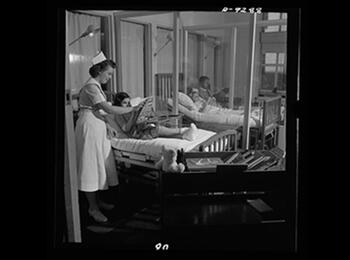
According to The Washington Post (May 6) “Expert say — and initial reports from European countries suggest — once the pandemic has subsides, roughly half of all deaths may be found to have occurred in assisted living homes.” My email inbox received a bulletin this morning (May 8) from the Committee to Unleash Prosperity giving powerful evidence that this may indeed be the case, and included a link to a nursing home fatality spreadsheet with data on 37 states and the District of Columbia (excerpt in Figure 1).
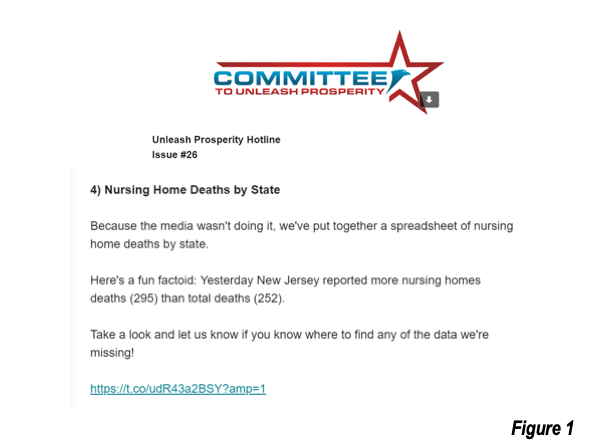
This had to be a really tough assignment. Nursing home fatality data is not reported and so the author(s) had to dig deeply to find it from different sources in each state.
New York and Illinois data were rated as “bad” and are not included in the discussion that follows. In the case of New York, the spreadsheet says: “NY is the only state to exclude deaths of nursing home residents who die at a hospital. Do not compare with other states.” The problem with the Illinois data is not described.
Most of the data is from the last three days (May 5-7), while the oldest is from May 1. The total number of cases, excluding New York and California, represents 83% of the national total. This is a large enough sample to suggest that the 50% plus estimate will turn out to be pretty accurate.
Among the 35 states and the District of Columbia, 52.5% of the fatalities have been in nursing homes, while fewer (47.5%) were elsewhere (Figure 2).
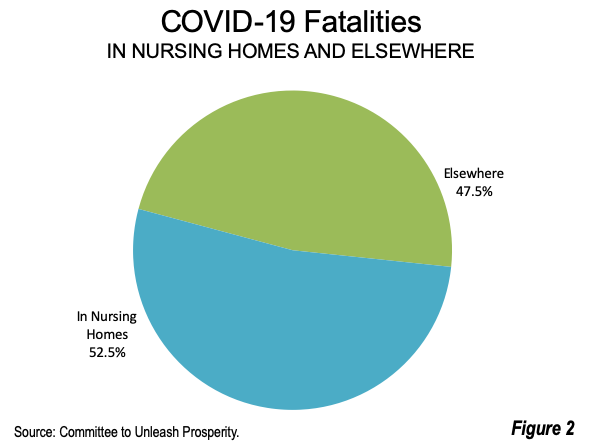
Most Impacted States
Among the most impacted states for which there are reliable reports, Minnesota has the highest share of COVID-19 nursing home deaths, at 80.2%. New Hampshire and Rhode Island are close behind, at 76.7% and 75.7%. The other states in the most impacted 10 with the highest nursing home death rates are Pennsylvania, Nebraska, Delaware, Washington, North Carolina, Massachusetts and Oregon, ranging down from 68.9% to 60.2% (Figure 3). Maryland and West Virginia area also at or above 60%.
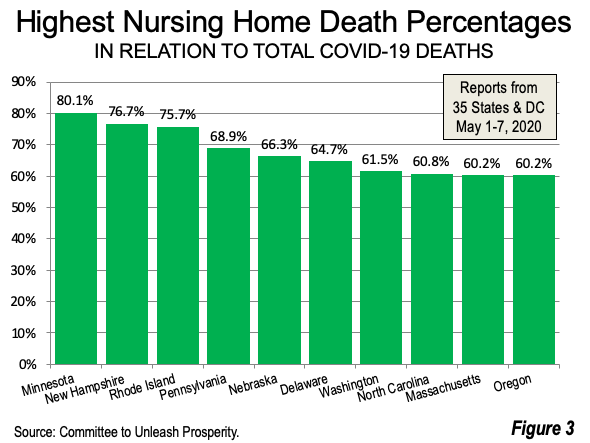
Least Impacted States
The ten least impacted states (and DC) include Nevada, at 19.6%, Tennessee, at 25.3% and the District of Columbia, at 27.9%. The other 10 least impacted states include South Carolina, Arkansas, Indiana, Alabama, Louisiana, Florida and Wisconsin. These states range from a nursing home death rate of 30.5% to 39.0% (Figure 4).
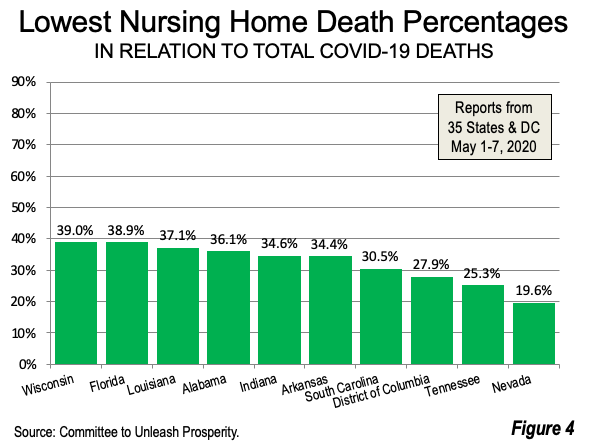
Learning from the Experience: Transitioning to the Digital Economy
Of course, this is still preliminary and incomplete data and may change. But surely nursing homes have emerged, like subways, and apparently airline travel from New York (and elsewhere) as virus seeding environments (see: Travel From New York City Seeded Wave of U.S. Outbreaks in The New York Times). We must all hope that nursing home professionals, and others, will be finding ways to prevent this from happening again to nursing home residents and their relatives who are denied visiting them and may see them prematurely taken away.
In our connected world, there are will likely to be additional epidemics in the future. We need to learn how to permit life to continue in any future epidemics. This will require making our lifestyles more immune to high exposure densities. There is an imperative not to destroy people’s lives and livelihoods by closing more than needs to be shut down. And, to be sure, with a decade’s worth of job growth negated in the single month of April, lives and livelihoods have been destroyed. Of course, as always occurs in such downturns, it is likely to be those at the bottom of the economic heap who pay the dearest price.
Wendell Cox is principal of Demographia, an international public policy and demographics firm. He is a Senior Fellow of the Center for Opportunity Urbanism (US), Senior Fellow for Housing Affordability and Municipal Policy for the Frontier Centre for Public Policy (Canada), and a member of the Board of Advisors of the Center for Demographics and Policy at Chapman University (California). He is co-author of the "Demographia International Housing Affordability Survey" and author of "Demographia World Urban Areas" and "War on the Dream: How Anti-Sprawl Policy Threatens the Quality of Life." He was appointed by Mayor Tom Bradley to three terms on the Los Angeles County Transportation Commission, where he served with the leading city and county leadership as the only non-elected member. Speaker of the House of Representatives appointed him to the Amtrak Reform Council. He served as a visiting professor at the Conservatoire National des Arts et Metiers, a national university in Paris.
Photograph: by Fritz Henle, via Wikimedia Rights Advisory: No known restrictions. For information, see U.S. Farm Security Administration/Office of War Information Black & White Photographs.












